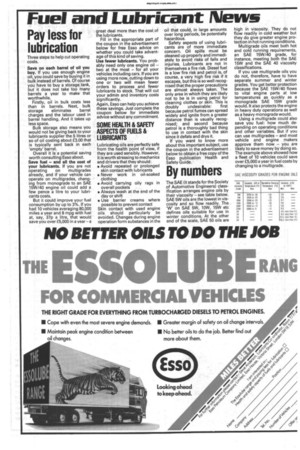Fuel and Lubricant News
Page 47

If you've noticed an error in this article please click here to report it so we can fix it.
Pay less for lubrication
Three steps to help cut operating costs.
Save on each barrel of oil you buy. If you use enough engine oil, you could save by buying it in bulk instead of barrels. Of course you have to buy a storage tank, but it does not take too many barrels a year to make that worthwhile.
Firstly, oil in bulk costs less than in barrels. Next, bulk storage eliminates barrel charges and the labour used in barrel handling, And it takes up less space.
Bulk storage also means you would not be giving back to your lubricants supplier the 5 litres or so of oil costing about £3,00 that is typically sent back in each 'empty' barrel.
Overall it is a potential saving worth consulting Esso about. Save fuel — and all the cost of your lubricants. If you are not operating on multigrades already, and if your vehicle can operate on multigrades, changing from monograde to an SAE 15\N/40 engine oil could add a few pence a litre to your lubricants costs.
But it could improve your fuel consumption by up to 3%. If you had 10 vehicles averaging 80,000 miles a year and 8 mpg with fuel at, say, 37p a litre, that would save you over £5,000 in a year--a great deal more than the cost of the lubricants.
Fill in the appropriate part of the coupon in the advertisement below for free Esso advice on whether you could take advantage of this kind of saving.
Use fewer lubricants. You probably need only one engine oil — two at the most — for all your vehicles including cars. If you are using more now, cutting down to one or two will mean fewer orders to process and fewer lubricants to stock. That will cut your admin and inventory costs significantly.
Again, Esso can help you achieve these savings. Just complete the coupon below for immediate advice without any commitment.
SOME HEALTH & SAFETY ASPECTS OF FUELS & LUBRICANTS
Lubricating oils are perfectly safe from the health point of view, if they are used sensibly. However, it is worth stressing to mechanics and drivers that they should: • Avoid repeated or prolonged skin contact with lubricants • Never work in oil-soaked clothing • Avoid carrying oily rags in overall pockets • Always wash at the end of the day or shift • Use barrier creams where possible to prevent contact Skin contact with used engine oils should particularly be avoided. Changes during engine operation form substances in the oil that could, in large amounts over long periods, be potentially hazardous.
Safety aspects of using lubricants are of more immediate concern. Oil spills must be dean ed up properly and immediately to avoid risks of falls and injuries. Lubricants are not in themselves a fire risk. Diesel fuel is a low fire risk and petrol is, of course, a very high fire risk if it escapes, but this is so well recognised thatthe proper precautions are almost always taken. The only area in which they are likely not to be is in using petrol for cleaning clothes or skin. This is doubly undesirable: first because petrol fumes can spread widely and ignite from a greater distance than is usually recognised; and second because petrol is a thoroughly bad thing to use in contact with the skin since it defats and drys it.
If you want to know more about this important subject, use the coupon in the advertisement below to obtain a free copy of the Esso publication Health and Safety Guide.
By numbers
The SAE (it stands for the Society of Automotive Engineers) classification arranges engine oils by their viscosity — see table below. SAE 5W oils are the lowest in viscosity and so flow readily. The 'W` on SAE 5W, 10W, 15W etc defines oils suitable for use in winter conditions. At the other end of the scale, SAE 50 oils are
high in viscosity. They do not flow readily in cold weather but they do give greater engine protection in hot running conditions. Multigrade oils meet both hot and cold running requirements, an SAE 15W/40 grade, for instance, meeting both the SAE 15W and the SAE 40 viscosity classifications.
If you use multigrade oils you do not, therefore, have to have separate summer and winter grades. You get better protection because the SAE 15W/40 flows to vital engine parts at low temperatures as quickly as a monograde SAE 15W grade would. It also protects the engine in heavy duty operations as well as a heavy monograde would.
Using a multigrade could also save you fuel: how much depending on operating conditions and other variables. But if you can use multigrades — and most vehicle and engine makers approve them now — you are likely to save money by doing so. The example above showed how a fleet of 10 vehicles could save over £5,000 a year in fuel costs by changing to a multigrade.




































































































